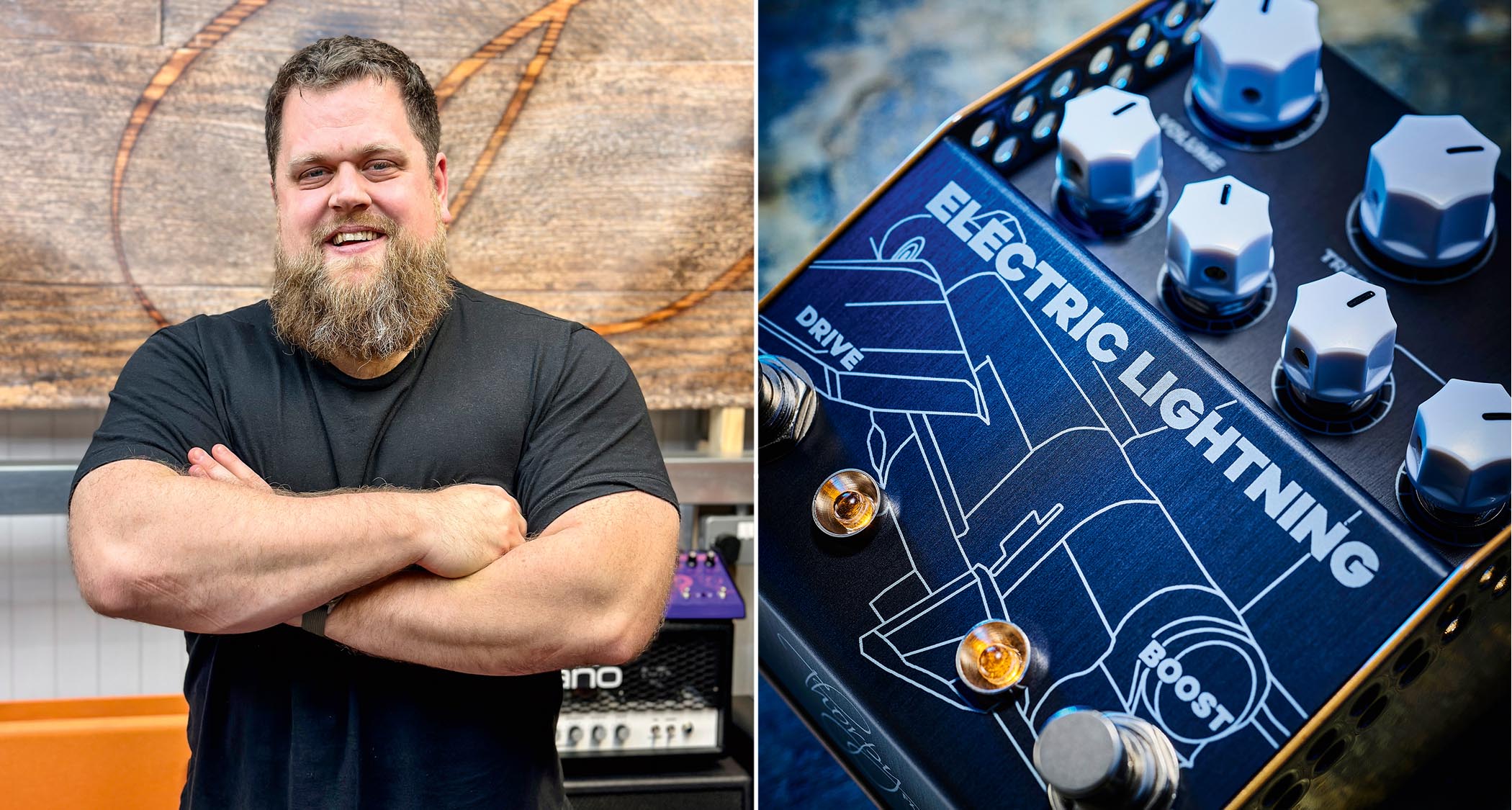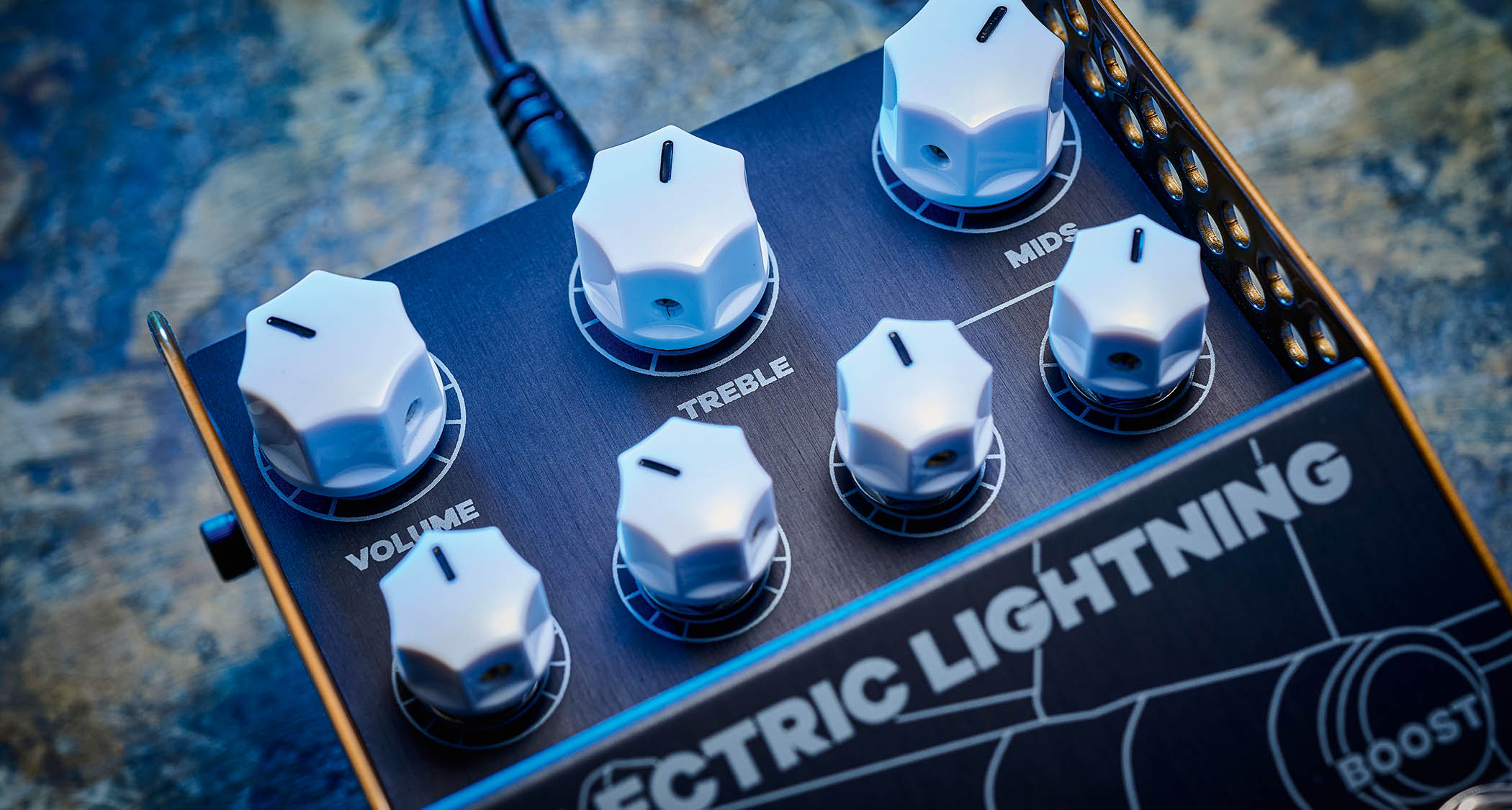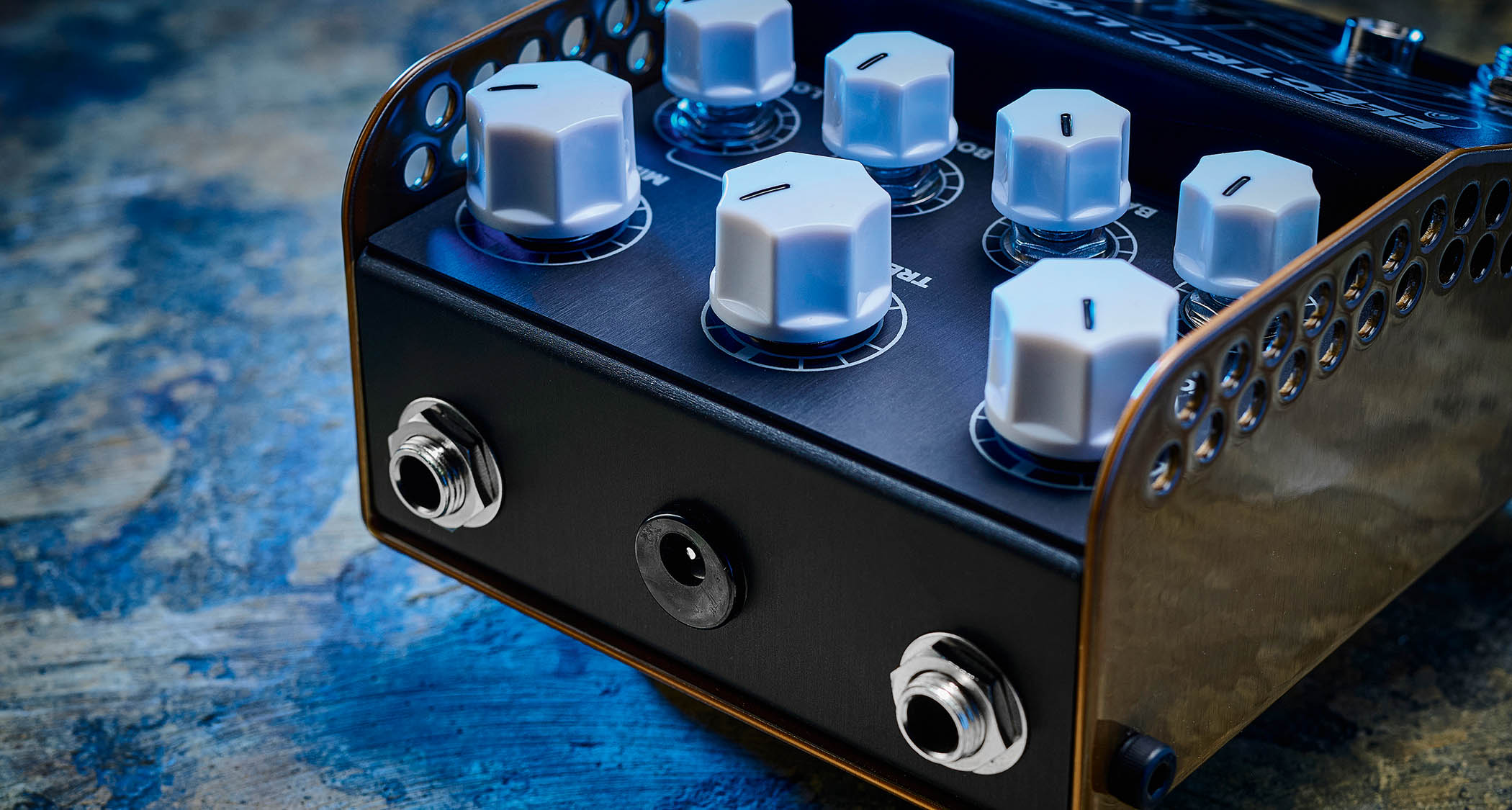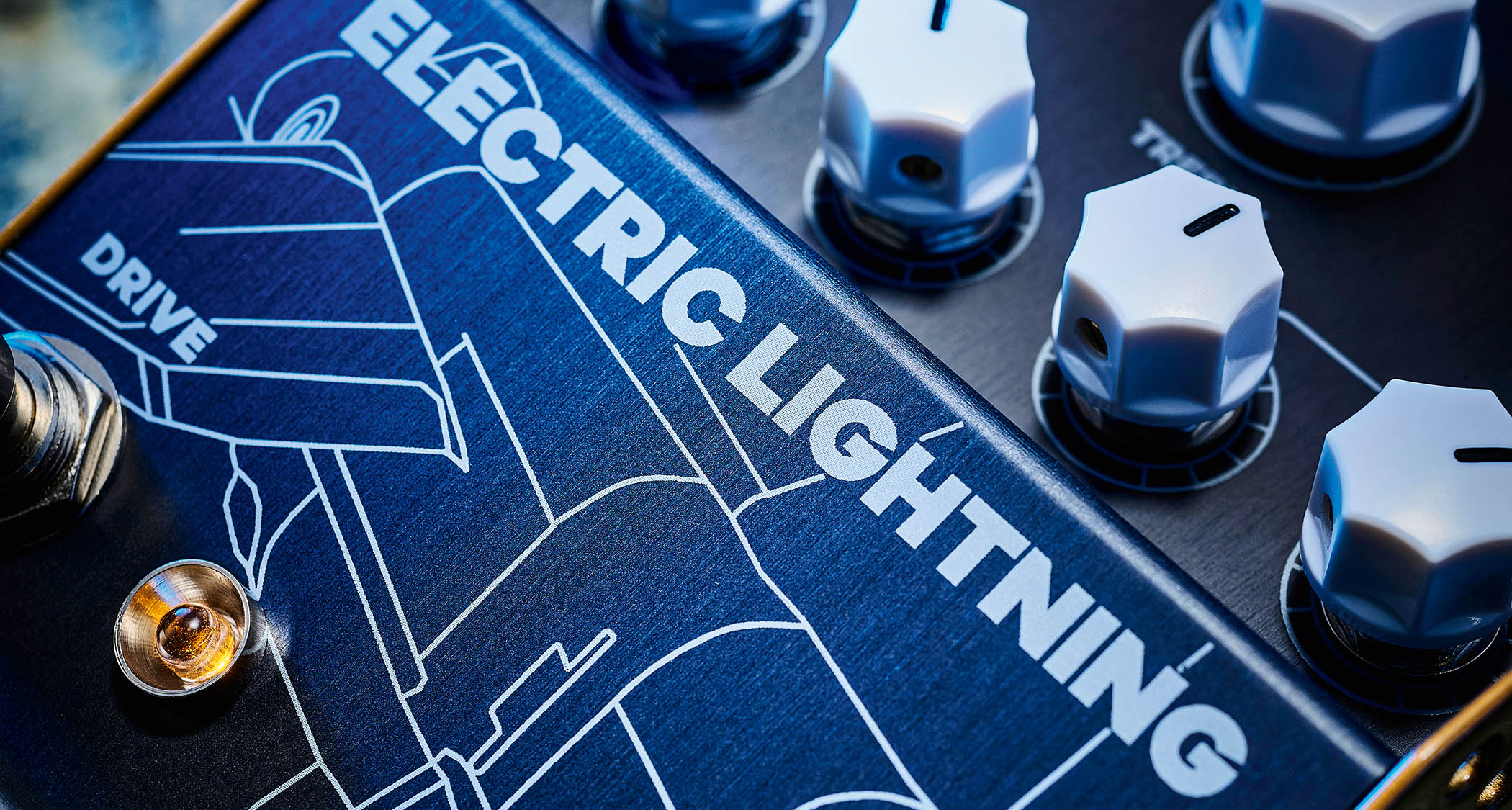“I said to him, ‘It needs to be valve. It needs to have that sag, that compression, that you can’t necessarily get from a solid-state design’”: Adrian Thorpe on how he made Chris Buck’s awesome, tube-equipped signature pedal, Electric Lightning
Adrian Thorpe of ThorpyFX remembers the flight path – and turbulence – behind Chris Buck’s Electric Lightning overdrive/boost, named after a fighter jet and packing a bona fide valve

When it comes to the story of the ThorpyFX Electric Lightning, perhaps the strangest aspect is that it didn’t happen sooner. Having watched the rise of his good friend Chris Buck in Cardinal Black, while gathering plaudits for his own Brackley, UK-based pedal operation, Adrian Thorpe finally popped the question during lockdown.
“I think I’ve always had it in the back of my mind that I’d love to make something for Chris,” says the affable designer (and former major in the British Army). “So it was just a conversation we had a few years ago. Like, ‘I know your pedalboard changes all the time, but I want to make something for you that’s absolutely exemplary – what can we do?’”
Launched earlier this year, the resulting valve-based overdrive/boost has already pricked up ears, reviewed earlier this year (“it delivers all the drive sounds you’ll need”), and regularly heard on Buck’s YouTube channel.
Now, says Thorpe, he hopes the Electric Lightning’s egalitarian design will see it adopted across the board. “We had it in our mind that it needed to be good for other people as well as Chris. So that’s designed in from the start.”

What was your shared vision for the Electric Lightning?
“Well, we’ve been friends for a long time. I’ve tried to support Chris, and vice versa, as we’ve both grown on our journey. At the point when Chris said, ‘Yeah, let’s make it happen,’ we hadn’t decided on anything, particularly. We just knew it needed to be something he could use with any rig, to sound like Chris, right?
“He’s renowned for using his Klons and Bluesbreakers, but he also tries everything and bounces between things, and he likes to stack things and all the rest of it. So we made the decision to do something a bit special for him – and went with a valve pedal.”
Get The Pick Newsletter
All the latest guitar news, interviews, lessons, reviews, deals and more, direct to your inbox!
Chris is such a vocal player, with lots of legato and fluid-sounding licks in his style. Why did a valve pedal seem the best way to complement that?
“Let’s start with the boost because obviously it’s a two-in-one. Chris always has something on. It was always either, like, a Bluesbreaker run very low or a Klon that’s got virtually no drive on it. But what he really liked about The Dane [ThorpyFX’s acclaimed overdrive/boost] was the Lows control.
“He played with that all the time, taking it on, taking it off, depending what guitar he was using. And as he’s moved away from Strats to P-90s, he was finding The Dane really useful for control over the lows.
“So when I said I wanted to build him something, he said, ‘Can I have this? But I want it to be able to cut and boost.’ I said, ‘Yeah, we can do that. It will change it ever so slightly and we need to tailor that for you, to make sure that the Lows control stays just as functional but isn’t impacted by having much less gain.’”

How did you approach the overdrive element of the pedal?
“The question was, from an overdrive perspective, where do you go? In theory, everything’s done, is it not? For The Dane, we designed everything from scratch for Pete Honoré but to a certain sonic footprint. And for Chris, I said to him, ‘I feel like it needs to be valve. It just needs to have that sag, that compression, that you can’t necessarily get from a solid-state design.’
“Especially as he sometimes travels with a [Line 6] Helix, and he sometimes travels with multiple valve amps. But a lot of the time – especially initially with Cardinal Black – you don’t always get to choose what your backline is. So it can be a bit difficult.
“So when you know you’ve got a ’board that’s reliable, can do the sounds you want, and you can DI it generally [it gives you peace of mind]. So that’s why we went that route: a) to provide that valve feel, that valve compression, and b) to give him that fatness to his single coils that he wouldn’t have got from anything else because this is a different design, a different pedal.”
How do you balance the artist’s wishlist with the need for the end product to appeal to a wider market?
“It’s a really hard process, if I’m honest. Because it requires both of you to park your ego a little bit. When we work with Chris or Pete, or whatever, we go: ‘What do you want? I want absolute honesty from you or we’re wasting our time. Don’t worry about my feelings. I’ve got thick skin and big shoulders. I’m good. Tell me how it is and tell me what you want. And if you’re struggling to articulate that, then show me what you want.’ Because it’s very difficult to articulate in words what you’re trying to show, feel-wise or sound-wise.
“I enjoy the process. I enjoy the end. There’s frustrations in between when we can’t quite get there or they can’t quite articulate it or some-such. But that’s part of the process. The real test is when they shut up and play it, solidly. And I’m sat there twiddling my thumbs, generally, going, ‘Erm, is it good?’ But it’s the silence that means it’s good. When they really like something, they lose themselves.
“How does that pan out to a product that other people will use? Well, thankfully, people like Chris are really attuned to the business side as well. He was like, ‘I don’t want my name plastered all over it because what if they don’t like me?’ So we put it on the box and that was all good.
“But Chris also said to me, ‘It needs to be commercially viable.’ His use for the boost is pretty much unity gain with a fatness control adding lows. But that’s no good for the majority of people. Most people wouldn’t understand that. So, commercially, it needed to be a boost that cut and boosted but also did the thing for Chris.
“It’s the same thing for the overdrive. There are settings in there that Chris will never approach. However, that’s good because other people can use it – because they haven’t all got Chris’s skills.”
What were the special considerations to keep in mind when using a valve?
“We run it what you would call ‘cold’. It’s essentially plus and minus 15 volts. So 30 volts internally, the current’s quite high. The voltage regime for a pedal like that is fascinating in that the boost needs to run at nine volts, you need plus and minus 15 volts, and you also need 12 volts for the heater.
The engineering of the pedal, to make sure it wasn’t noisy or whatever, was the biggest challenge
“Within the pedal, you’ve got plus 12, plus 15, minus 15, plus nine, and then obviously a ground reference. Trying to package that – shrink that down and put it all together – is a problem. And the engineering of the pedal, to make sure it wasn’t noisy or whatever, was the biggest challenge.
“Weirdly, one thing that was difficult was the LEDs. In the early prototypes, we kept getting a ‘pop’ from the LEDs. And what was happening was, the LEDs were coming on and there’s a voltage differential that was sagging on the power light. So we ended up designing something to soft-start the LEDs so they didn’t spike.
“Perceptibly, you can’t see that they come on slower, but they do. And it’s removed all the pop from the pedal. There’s a whole load of circuitry on there that wasn’t on there before, that essentially decouples the LEDs from everything and soft-starts them using a transistor system. It’s really cool.”

You could obviously run the Electric Lightning into the front of an amp. Could you also run it into the effects return and use it like a preamp stage?
“I guess you could. I mean, I wouldn’t; I haven’t designed it that way. You might have some noise issues. I don’t really design for loops for amps. I’ll tell you why: I freaking hate them! And the reason I hate them is they’re non-standardized and every one is different, and because all the amps are different, you can’t design for them.
“I mean, you can design roughly, but everything feels like a compromise. With certain amps – and I won’t name names – the loops are terrible. I just can’t cope with them.”
The Electric Lightning is named after a British interceptor aircraft, isn’t it?
“Do you know what’s funny about that name? Between me and Chris, we had to come up with something. I wanted it to have some sort of nod to Wales, so I presented him with this idea inspired by the English Electric Lightning, the plane.
“There’s a great story about a Welsh engineer who accidentally took off while doing a ground test – and he flew the thing and landed it. We’ve had loads of grief from people going, ‘Of course lightning is electric, durr.’ And I’m like, ‘Yeah, there’s a plane on it, mate…!’”
- The Electric Lightning is available now. See ThorpyFX for more details.
Jamie Dickson is Editor-in-Chief of Guitarist magazine, Britain's best-selling and longest-running monthly for guitar players. He started his career at the Daily Telegraph in London, where his first assignment was interviewing blue-eyed soul legend Robert Palmer, going on to become a full-time author on music, writing for benchmark references such as 1001 Albums You Must Hear Before You Die and Dorling Kindersley's How To Play Guitar Step By Step. He joined Guitarist in 2011 and since then it has been his privilege to interview everyone from B.B. King to St. Vincent for Guitarist's readers, while sharing insights into scores of historic guitars, from Rory Gallagher's '61 Strat to the first Martin D-28 ever made.
“The original Jordan Boss Tone was probably used by four out of five garage bands in the late ’60s”: Unpacking the gnarly magic of the Jordan Boss Tone – an actual guitar plug-in that delivers Dan Auerbach-approved fuzz
“This is a powerhouse of a stompbox that manages to keep things simple while offering endless inspiration”: Strymon EC-1 Single Head dTape Echo pedal review














